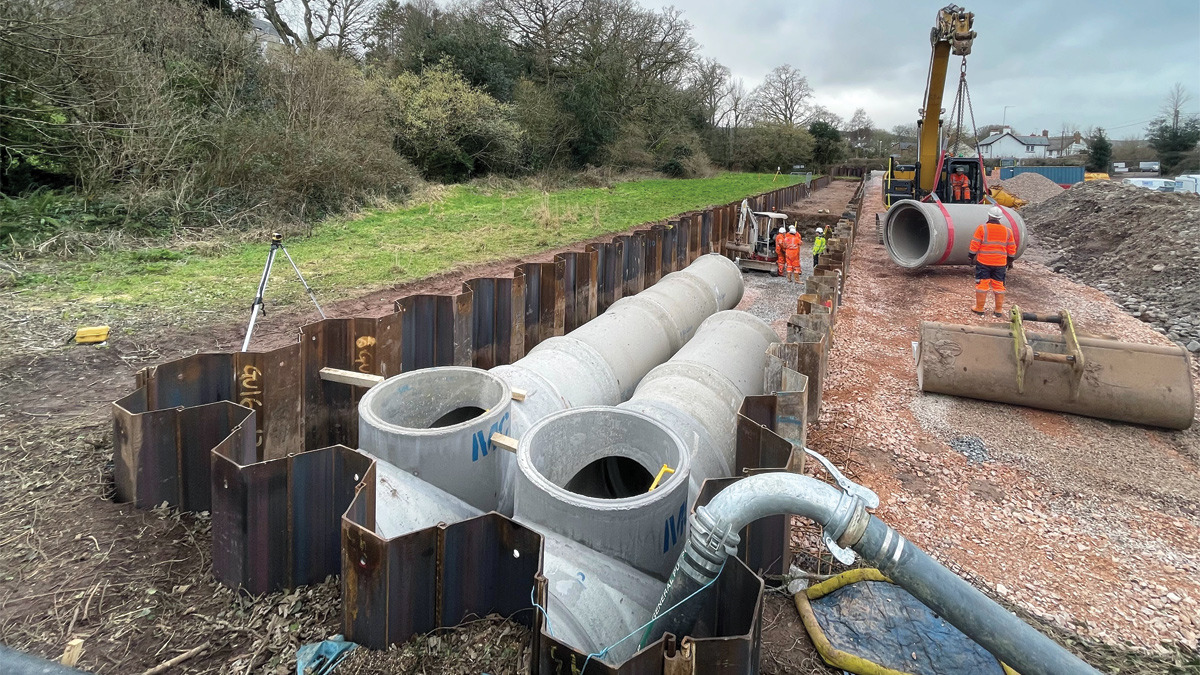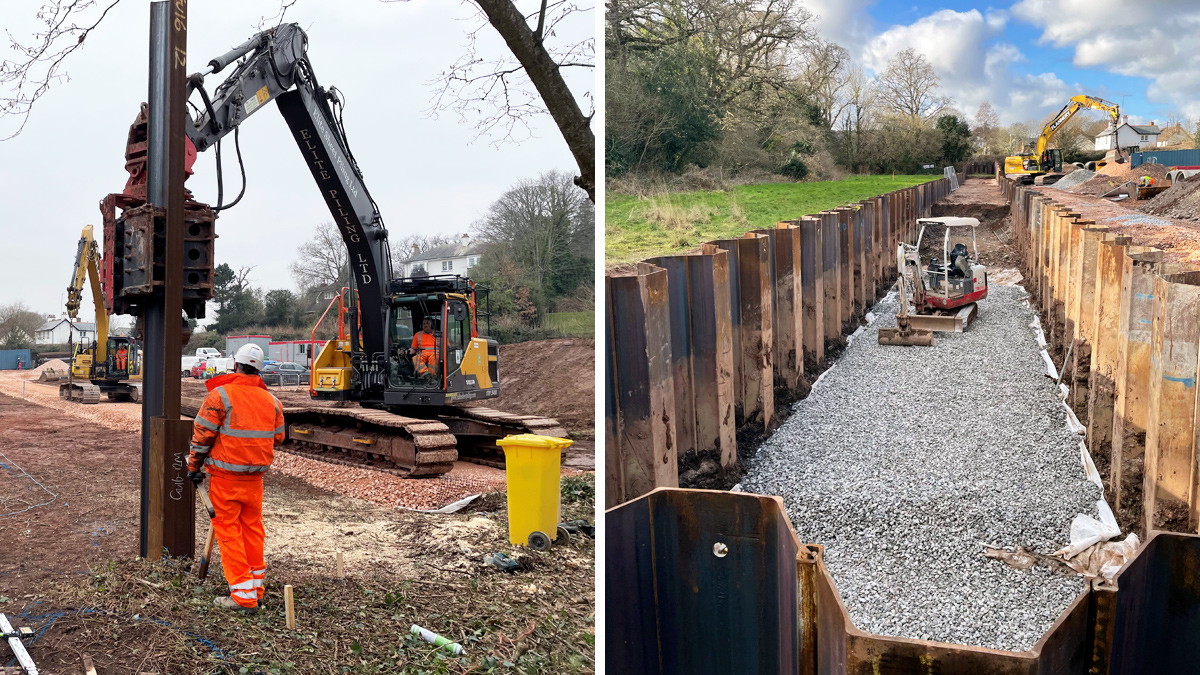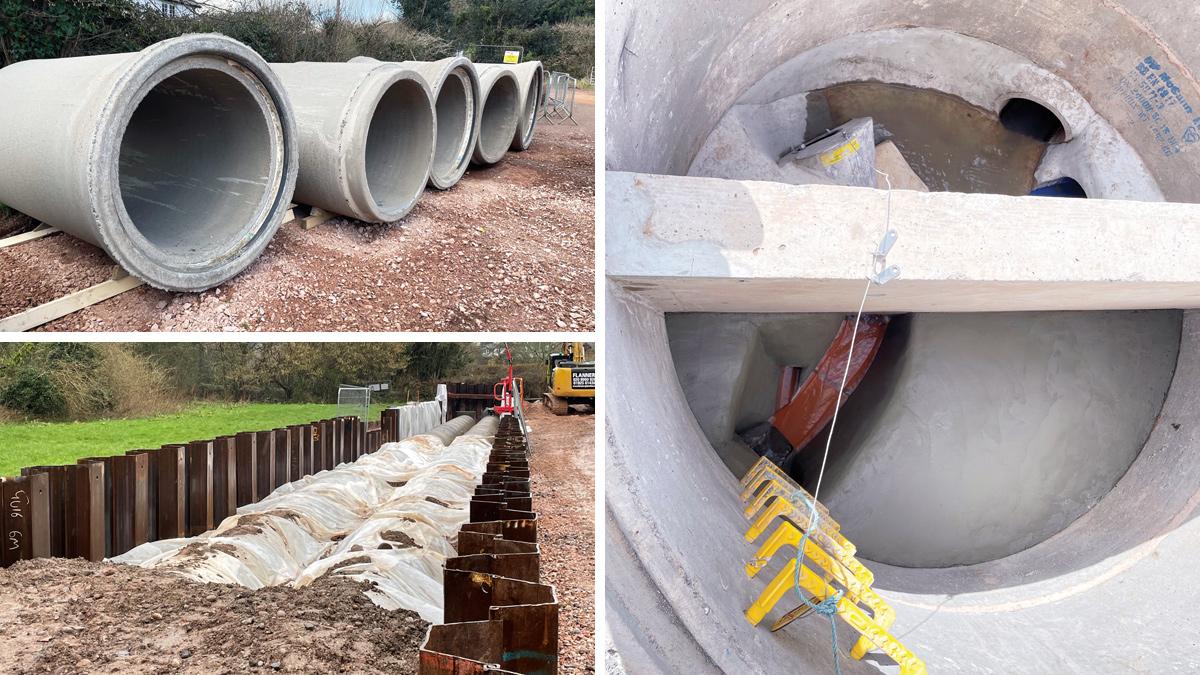Meadow Road Stormwater Tank (2023)

Constructing the 83m lengths of 1200mm precast concrete pipes - Courtesy of Galliford Try
Budleigh Salterton is a seaside town on the coast in east Devon, at the start of the World Heritage Jurassic Coast, with a population of just over 5,000 people. It has been described as a picturesque town with a two-mile pebble beach for the hardy swimmers braving the seas for a dip in the beautiful clear water. South West Water’s objective was to ensure that the bathing water quality at Budleigh Salterton does not deteriorate to below ‘excellent’ within the next 20 years. This was to be achieved by providing in-line tank storage in combination with the removal of 0.31ha of surface water from the combined system, in order to ensure that no greater than two significant (>50m3) spills per bathing water season was achieved by 31 March 2022.
Project background
The project comprised the installation of an in-line 190m3 stormwater tank constructed from two 83m lengths of 1200mm diameter precast concrete pipes laid adjacent to the existing sewer. The inlet to the storage tank is controlled by the level within the existing sewer. So when the flow increases within the sewer, the level rises and starts filling the tanks. The outlet flow has a weir fitted with a flow control Hydro-Brake® allowing 25 l/s to pass forward. The project was constructed within a grassed field which was within a flood risk area.
Temporary works piling
The excavation support system (the temporary works) consisted of a 90m long x 4m wide cofferdam within the flood risk area. Galliford Try constructed an engineered haul road which doubled as the piling platform from which specialist sub-contractor, Elite Sheet Piling Ltd, installed 310 (No.) GU13, 6m long sheet piles using a 35t excavator mounted, side griping MOVAX pile driver.
Once the sheet piles were installed, the ground between the sheet piles was removed and taken off site. The sheet piles were designed to cut off any groundwater entering their excavation from the adjacent river.
One of the major risks to the scheme was that as soon as Galliford Try excavated the large 90m long 4m wide trench it would be inundated with groundwater, making it impossible to safely install the precast concrete pipe sections. The cofferdam worked perfectly; cutting off all incoming groundwater. Once the ground trapped within the cofferdam was removed, the excavation remained dry during the pipe installation.
Drainage blanket
Following the excavation of the cofferdam, a drainage blanket was installed in the bottom of the trench. This comprised a 200mm thick layer of 50mm singled sized stone which was then covered over with a 1000 guage geotextile membrane from Terram; helping to prevent the intermixing of solid particles between the layers of soil and acting as a filter layer stopping any fine material getting into the drainage blanket layer.

(left) Piling installation by Elite Sheet Piling Ltd, and (right) drainage blanket installation – Courtesy of Galliford Try
Pipe installation
With the drainage blanket complete, Galliford Try started the installation of the 62 (No.) 1200mm diameter precast concrete pipe sections, which were laid on 20mm pipe bedding materials and aligned using a pipe laser. The pipe laser was installed by the site engineer at the correct location with the exact fall from end to end of the 90m cofferdam. A 20t excavator was used to lift the pipe sections along the haul road and down into the cofferdam where the pipe laying gang would place them in accordance with the pipe laser. Once all the pipe sections were installed, the team backfilled the pipe sections with pipe bedding then, as dug soil back up to ground level.
Meadow Lane Stormwater Tank: Supply chain – key participants
- Delivery contractor: Galliford Try
- Modelling: Arcadis
- Piling contractor: Elite Sheet Piling Ltd
- Hydro-Brake®: Hydro International
- Geotextile membrane: Terram
- Cofferdam shoring: MGF Ltd
- Precast concrete pipe sections: FP McCann
- Pump hire: SLD Pumps & Power
Other elements
At each end of the storm tank, Galliford Try installed tee sections of pipe creating a manifold, which connected the twin pipe together to form one large tank. Galliford Try then constructed six inspection chambers to provide access and to house the Hydro-Brake® flow control. This only allows a pass forward flow of 25 l/s at maximum design head; above these flow rates it weirs over a bypass to prevent the sewer backing up. Once the storm event is over, the stormwater within the tank is slowly released back into the existing sewer during periods of dry weather flow.

(top left) 1200mm precast concrete pipe sections, (bottom left) backfilling the stormwater tank, and (right) Hydro-Brake® from Hydro International in flow control chamber – Courtesy of Galliford Try
Summary
By providing 190m3 of offline, gravity return storm storage in the field adjacent to Halse Hill, Budleigh Salterton, the spill performance at Meadow Road CSO has been improved in line with South West Water and Environment Agency targets. As the storage is to be provided offline, normal dry weather flow is to be maintained through existing sewer.
The agreed storage tank volume, flow control device and overflow weir level were derived from the Arcadis modelling report and taken as the scheme output for the storage element. The final tank volume selection/spill performance of the promoted option was operationally reviewed by the SWW operations team, commissioning engineer and asset management.





